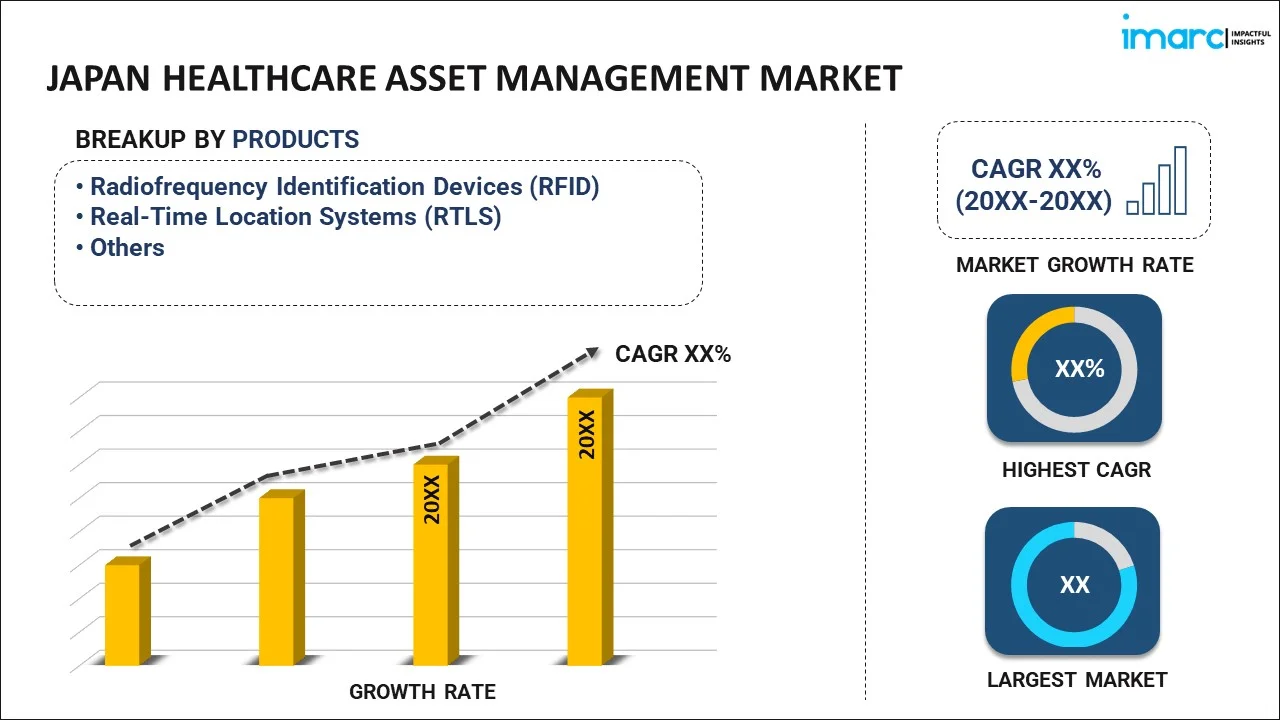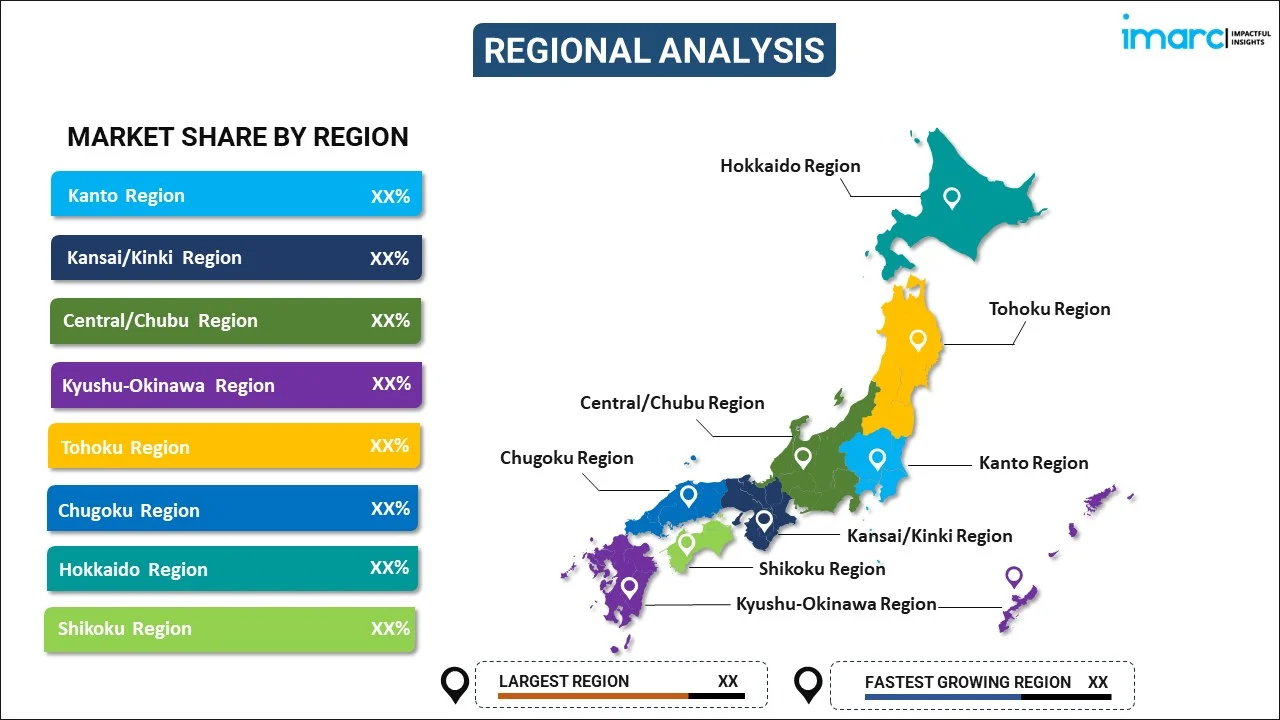
Japan Healthcare Asset Management Market Report by Product (Radiofrequency Identification Devices (RFID), Real-Time Location Systems (RTLS), and Others), Application (Hospital Asset Management, Pharmaceutical Asset Management), End User (Hospitals and Clinics, Laboratories, Pharmaceutical Companies, and Others), and Region 2025-2033
Market Overview:
Japan healthcare asset management market size reached USD 1.1 Billion in 2024. Looking forward, IMARC Group expects the market to reach USD 1.6 Billion by 2033, exhibiting a growth rate (CAGR) of 4.7% during 2025-2033. Government bodies and healthcare organizations are implementing stringent regulations to ensure patient safety, which is primarily driving the market growth.
|
Report Attribute
|
Key Statistics
|
|---|---|
|
Base Year
|
2024
|
|
Forecast Years
|
2025-2033
|
|
Historical Years
|
2019-2024
|
|
Market Size in 2024
|
USD 1.1 Billion |
|
Market Forecast in 2033
|
USD 1.6 Billion |
| Market Growth Rate 2025-2033 | 4.7% |
Healthcare asset management is the methodical supervision and monitoring of assets within the healthcare sector. It encompasses the application of technology, processes, and methodologies to efficiently oversee and uphold medical equipment, supplies, and other tangible assets. The objective is to enhance the utilization, availability, and lifespan of assets while minimizing costs and elevating patient care. Healthcare asset management systems frequently leverage diverse technologies like barcoding, RFID (Radio Frequency Identification), or IoT (Internet of Things) devices for real-time tracking and management of assets. This ensures precise inventory management, diminishes equipment downtime, improves patient safety, and streamlines operational efficiency within healthcare facilities.
Japan Healthcare Asset Management Market Trends:
The Japan healthcare asset management market is witnessing substantial growth, propelled by the escalating demand for efficient inventory management and cost control within healthcare facilities. Notably, technological advancements, particularly the integration of the Internet of Things (IoT) and real-time location systems (RTLS), are playing a pivotal role in driving market expansion. These advanced technologies provide superior asset tracking capabilities, enabling healthcare providers to locate and manage assets in real-time, thereby streamlining workflows and enhancing operational efficiency. Furthermore, the imperative for effective healthcare supply chain management is a significant factor contributing to the widespread adoption of asset management solutions in the country. Apart from this, through the efficient management and tracking of assets, healthcare organizations can optimize their supply chain processes, minimize waste, mitigate stockouts, and enhance overall supply chain performance, which is acting as another significant growth-inducing factor. Additionally, the increased spending by governments and healthcare organizations on healthcare infrastructure, including medical equipment and devices, further contributes to the positive trajectory of the Japan healthcare asset management market. This aligns with the emerging trend of prioritizing robust healthcare systems and efficient resource utilization, which is anticipated to fuel the regional market over the forecasted period.
Japan Healthcare Asset Management Market Segmentation:
IMARC Group provides an analysis of the key trends in each segment of the market, along with forecasts at the country level for 2025-2033. Our report has categorized the market based on product, application, and end user.
Product Insights:

- Radiofrequency Identification Devices (RFID)
- Real-Time Location Systems (RTLS)
- Others
The report has provided a detailed breakup and analysis of the market based on the product. This includes radiofrequency identification devices (RFID), real-time location systems (RTLS), and others.
Application Insights:
- Hospital Asset Management
- Staff Management
- Equipment Tracking and Management
- Patient Management
- Others
- Pharmaceutical Asset Management
- Drug Anti-counterfeiting
- Supply Chain Management
A detailed breakup and analysis of the market based on the application have also been provided in the report. This includes hospital asset management (staff management, equipment tracking and management, patient management, and others) and pharmaceutical asset management (drug anti-counterfeiting and supply chain management).
End User Insights:
- Hospitals and Clinics
- Laboratories
- Pharmaceutical Companies
- Others
The report has provided a detailed breakup and analysis of the market based on the end user. This includes hospitals and clinics, laboratories, pharmaceutical companies, and others.
Regional Insights:

- Kanto Region
- Kansai/Kinki Region
- Central/ Chubu Region
- Kyushu-Okinawa Region
- Tohoku Region
- Chugoku Region
- Hokkaido Region
- Shikoku Region
The report has also provided a comprehensive analysis of all the major regional markets, which include Kanto Region, Kansai/Kinki Region, Central/ Chubu Region, Kyushu-Okinawa Region, Tohoku Region, Chugoku Region, Hokkaido Region, and Shikoku Region.
Competitive Landscape:
The market research report has also provided a comprehensive analysis of the competitive landscape. Competitive analysis such as market structure, key player positioning, top winning strategies, competitive dashboard, and company evaluation quadrant has been covered in the report. Also, detailed profiles of all major companies have been provided.
Japan Healthcare Asset Management Market Report Coverage:
| Report Features | Details |
|---|---|
| Base Year of the Analysis | 2024 |
| Historical Period | 2019-2024 |
| Forecast Period | 2025-2033 |
| Units | Billion USD |
| Scope of the Report | Exploration of Historical and Forecast Trends, Industry Catalysts and Challenges, Segment-Wise Historical and Predictive Market Assessment:
|
| Products Covered | Radiofrequency Identification Devices (RFID), Real-Time Location Systems (RTLS), Others |
| Applications Covered |
|
| End Users Covered | Hospitals and Clinics, Laboratories, Pharmaceutical Companies, Others |
| Regions Covered | Kanto Region, Kansai/Kinki Region, Central/ Chubu Region, Kyushu-Okinawa Region, Tohoku Region, Chugoku Region, Hokkaido Region, Shikoku Region |
| Customization Scope | 10% Free Customization |
| Post-Sale Analyst Support | 10-12 Weeks |
| Delivery Format | PDF and Excel through Email (We can also provide the editable version of the report in PPT/Word format on special request) |
Key Questions Answered in This Report:
- How has the Japan healthcare asset management market performed so far and how will it perform in the coming years?
- What has been the impact of COVID-19 on the Japan healthcare asset management market?
- What is the breakup of the Japan healthcare asset management market on the basis of product?
- What is the breakup of the Japan healthcare asset management market on the basis of application?
- What is the breakup of the Japan healthcare asset management market on the basis of end user?
- What are the various stages in the value chain of the Japan healthcare asset management market?
- What are the key driving factors and challenges in the Japan healthcare asset management?
- What is the structure of the Japan healthcare asset management market and who are the key players?
- What is the degree of competition in the Japan healthcare asset management market?
Key Benefits for Stakeholders:
- IMARC’s industry report offers a comprehensive quantitative analysis of various market segments, historical and current market trends, market forecasts, and dynamics of the Japan healthcare asset management market from 2019-2033.
- The research report provides the latest information on the market drivers, challenges, and opportunities in the Japan healthcare asset management market.
- Porter's five forces analysis assist stakeholders in assessing the impact of new entrants, competitive rivalry, supplier power, buyer power, and the threat of substitution. It helps stakeholders to analyze the level of competition within the Japan healthcare asset management industry and its attractiveness.
- Competitive landscape allows stakeholders to understand their competitive environment and provides an insight into the current positions of key players in the market.
Need more help?
- Speak to our experienced analysts for insights on the current market scenarios.
- Include additional segments and countries to customize the report as per your requirement.
- Gain an unparalleled competitive advantage in your domain by understanding how to utilize the report and positively impacting your operations and revenue.
- For further assistance, please connect with our analysts.
 Inquire Before Buying
Inquire Before Buying
 Speak to an Analyst
Speak to an Analyst
 Request Brochure
Request Brochure
 Request Customization
Request Customization




.webp)




.webp)












